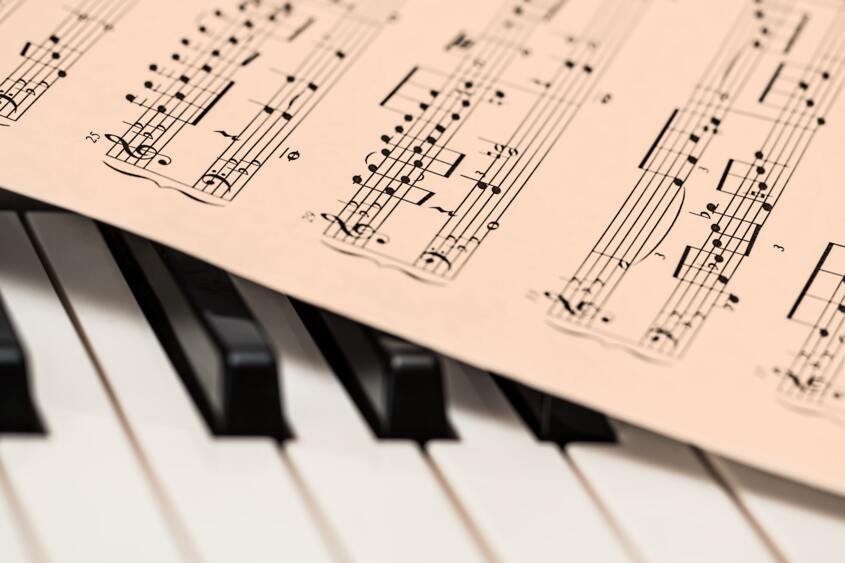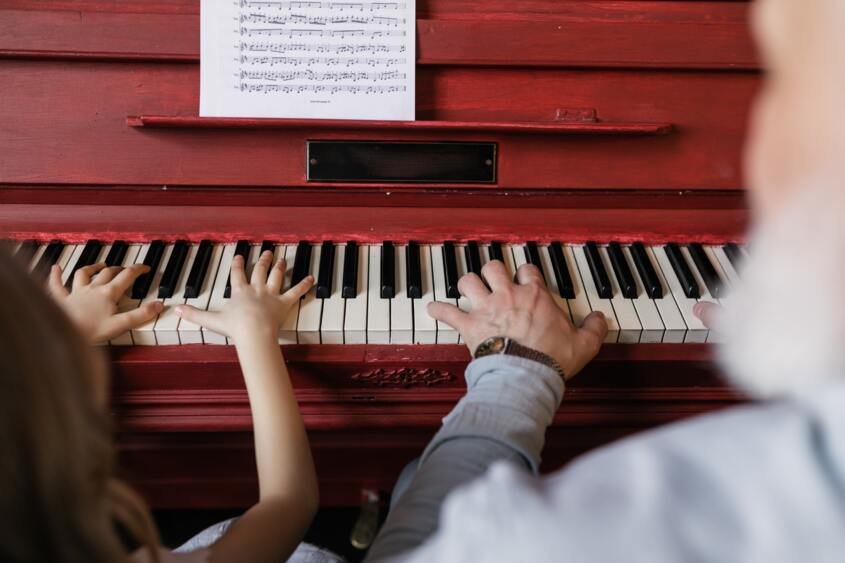Basic Piano Chords To Quickly Learn New Songs
Have you always had a keen interest in the piano but never had the time or know-how to get started? With the help of this article, you will be able to play your favorite songs on the piano and sing along to your heart’s content without needing years of practice. You only need to learn basic piano chords to get started. Sounds impossible? Read more to find out.
Before we begin
If you have some experience playing the piano, then this article is the perfect fit for you. However, if you’ve never played a single key in your life, then we suggest you go through our article on 7 Easy Piano songs for beginners first. This article contains the most rudimentary list of songs to get you started on your journey to becoming the 21st Century Beethoven. This article will still cover all the basics that you will need to know.
For starters, you will need a keyboard or a piano. Moreover, you will need to dedicate a small portion of your time daily to become better at playing this wonderful instrument. With a little bit of hard work, we assure you that you will be able to play all of your favorite songs in no time!
We have found a full 61 keyboard piano set for you with a stand, headphones, and more for under $199!
For more information Click Here!
What exactly is a ‘chord’?

A chord is constructed when more than one note is played at the same time & contains two, three, four, or more individual notes. Every time you press more than one key on your piano, you’re playing a chord.
Here is a great product for beginners to master any chord on any size keyboard with these stickers.
For more information Click Here!
The Basics - Piano Intervals
A piano interval refers to the distance between piano notes. They determine how the notes sound when played together. Intervals are measured in half-steps (semitones) & whole-steps (whole tones).
- Half-Steps (Semitones) - A half-step is the difference between one key to the next immediate key either to its left or right.
- Whole-steps (Whole Tones) - It is the distance of two half-steps.
- Common intervals - In piano chords, the common interval is the major third and is the difference of two whole-steps (four half-steps).
Never forget chords again! Set this cheat sheet on the piano and master any song!
For more information Click Here!
The Basics - Triad Chords
In this article, you will be learning about triad chords as well. A triad is any chord that contains three notes. A root, a third & a fifth.
The Root Note
All piano chords have a root note. The root note is what the chord is named after. It is played simultaneously with other notes to create the chord. In most cases, basic piano chords contain only two or three notes. Whereas advanced chords usually tend to have more notes.
The Third Note
The Third is the middle note of the chord. It is quite important as it determines whether the chord is a major chord or a minor chord.
The Fifth Note
The remaining note is called the Fifth note. The Fifth closes out the triad sonically and adds a sense of weight or stability to it. The fifth is important because it determines whether a chord is augmented or diminished.
Can’t tell one note on the piano from the other? Check out our guide on how to remember piano notes.
Major Chords
A major chord is said to sound ‘happier’ or ‘brighter’ - it has a warm tone. A major third is 4 semitones, & the major fifth is 7 semitones from the root note respectively.
Here are some common major piano chords -
- C major (C). C - E - G
- D major (D). D - F# - A
- E major (E). E - G# - B
- F major (F). F - A - C
- G major (G). G - B - D
Minor Chords
The sound that comes from minor chords is often associated with the notions of melancholy & darkness. The minor third is 3 semitones & the minor fifth is 7 semitones from the root chord respectively.
Here are some common minor piano chords -
- C minor (Cm). C - Eb - G
- C# minor (C#m). C# - E - G#
- D minor (Dm). D - F -A
- Eb minor (Ebm). Eb - Gb - Bb
- E minor (Em). E - G - B
Augmented Chords
Augmented chords are said to sound ‘surreal’ or ‘bizarre’. It is built from two major thirds which build up to an augmented fifth. In an augmented chord, the fifth is 7 semitones away from the root.
Commonly used augmented chords include -
- C augmented (Caug). C - E - G#
- C# augmented (C#aug). C# - E# - G##
- E augmented (Eaug). E - G# - B#
- G augmented (Gaug). G - B - D#
- G# augmented (G#aug). G# - B# - D##
Diminished Chords
Diminished chords sound eerie and sinister. It is built from two minor thirds which build up to an augmented fifth. In a diminished chord, the fifth is 6 semitones away from the root.
Commonly used diminished piano chords include -
- F diminished (Fdim). F - Ab - Cb
- C# diminished (C#dim). C# - E - G
- C diminished (Cdim). C - Eb - Gb
- F diminished (Fdim). F - Ab - Cb
- F# diminished (F#dim). F# - A - C
What are Chord Progressions?

Photo by Alena Darmel from Pexels
A Chord Progression is a series of chords played on the piano in a sequence. Chord progressions provide a structure to songs and main consistency throughout. They exist to develop music in a harmonically meaningful manner. There is a “harmonic story” in each progression that contains a beginning, a middle & an end. Some popular chord progressions are -
- The 4 Chord Song Progression - C - G - Am - F
- Cadential Chord Progression - Dmin - G - C
- Classic 3 Chord Progression - C - F - G
- 50s Chord Progression - C - Am - F - G
The 4 Chord Song Progression - The Most Popular Chord Progression of Our Era
The 4 Chord Song Progression is the most popular chord progression of our era. You have probably heard this progression being used in many of your favorite songs and may not have noticed. The chords used in this progression are -
- C major (C)
- F major (F)
- A minor (Am)
- F major (Fm)
There is a mathematical reason that explains why this chord is so frequently used. To summarize, the 4 chords that create this progression are opposites of each other. The G chord is the opposite of the C, and the A minor chord is the opposite of the F major. These chords create complimentary frequencies that our brains instinctively gravitate towards.
Some notable songs composed using this progression include -
- Bob Marley - “No Woman No Cry”
- The Beatles - “Let It Be”
- Journey - “Don’t Stop Believing”
- Adele - “Someone Like You”
- Train - “Hey Soul Sister”
The Cadential Chord Progression
This progression is commonly used in classical, gospel & church settings. In a cadential progression, the tonal function of the chords are defined & audible which eventually resolves into a chord of rest & purpose. The chords used in this progression are -
- D minor (Dm)
- G major (G)
- F major (F)
Some notable songs composed using this progression include -
- Eric Clapton - “Tears in Heaven”
- Miles Davis - “Tune Up”
- Maroon 5 - “Sunday Morning”
If you want to be able to play these amazing songs, you will need to practice. Confused about where to start? Check out our guide on 14 piano practice tips you need to learn.
The Classic 3 Chord Progression
This is one of the most diverse yet simple piano chord progressions. It is used as the basis for a lot of songs, particularly modern pop. You can easily improvise playing this progression since the chord progression itself does not require a lot of concentration. The chords used in this progression are -
- C major (C)
- F major (F)
- G major (G)
Some notable songs composed using this progression include -
- Jerry Lee Lewis - “Great Balls of Fire”
- Poison - “Every Rose Has Its Thorn”
- Richie Valen - “La Bamba”
The 50’s Chord Progression - “The Heart & Soul” chords
This chord was popularised in the ‘50s and is still used today. It was associated with the ‘doo-wop’ genre of rhythm & blues that was popular during the ‘50s and ‘60s. The chords used in this progression are -
- C major (C)
- A minor (Am)
- F major (F)
- G major (G)
Some notable songs composed using this progression include -
- Ben E. King - Stand by Me
- Rebecca Black - Friday
- Coldplay - Viva La Vida
- Bonnie Tyler - Total Eclipse of Heart
All of the songs mentioned above are classics. You might be able to create a masterpiece of your own in the future as well, if not then at least learn how to play other classical pieces. If these songs have inspired you to want to learn how to play the piano, check out our complete guide to Learning The Piano in 2021 first.
Departing Advice
Songs are probably one of the best ways to express how we feel. To be able to do so on your own accord with skills you’ve acquired through diligence and hard work is a sense of satisfaction that cannot be expressed through words.
Practice the basic chords and progressions mentioned in this article and you will be able to play your favorite songs. And perhaps even take a step towards becoming a great pianist yourself.
Something that would help you on this journey would be to have guidance from an inspiring teacher who would be able to teach you how to play the piano in an organized & structured manner. This would make your practice sessions more productive and you would be able to receive constructive feedback and would also be able to track your progress properly.
To find the perfect teacher for you, online or in-person near your residence, sign up to The Best Piano Teachers for FREE today!
Which piano chord do you think you'll get started with?
